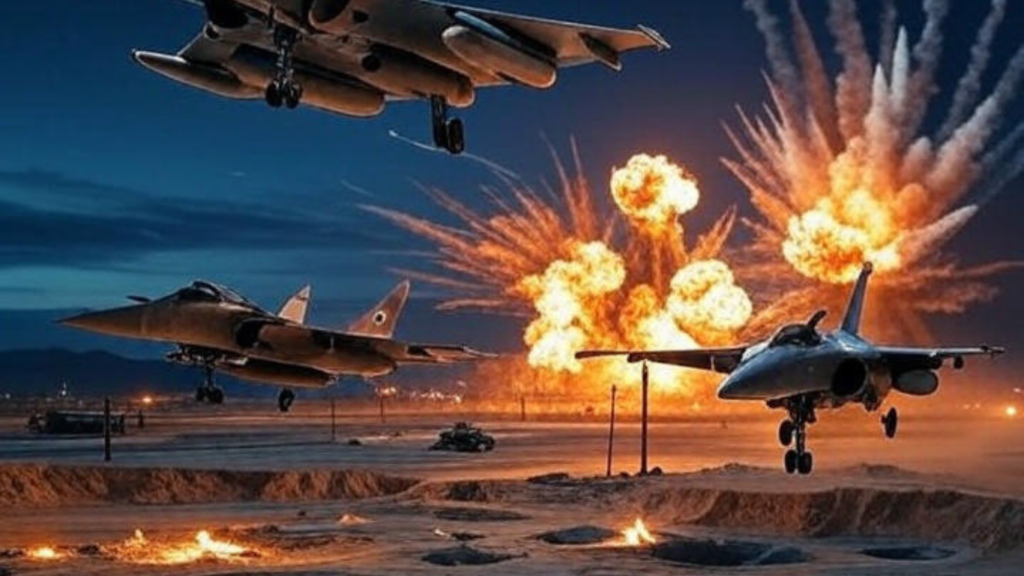On the night of May 9, 2025, the skies over Pakistan lit up with fire and chaos. In a bold and calculated move, the Indian Air Force (IAF) launched Operation Sindoor, a series of precision airstrikes that crippled the Pakistan Air Force (PAF). Reports estimate that 20-30% of Pakistan’s air power—bases, fighter jets, and critical infrastructure—was destroyed in a single night. This wasn’t just a military strike; it was a statement of India’s strength and resolve, triggered by a terrorist attack in Pahalgam, Jammu and Kashmir, on April 22, 2025, that killed 26 civilians. What unfolded was one of the most intense air battles in recent history, a night that left Pakistan reeling and the world watching. Let’s dive into how India pulled off this devastating operation, breaking down the strategy, targets, and impact, while keeping the story grounded and human.
The Spark: Why India Struck
The roots of Operation Sindoor trace back to the Pahalgam attack, a brutal act blamed on Pakistan-backed terrorists. India’s patience snapped. After weeks of rising tensions, Pakistan’s attempt to hit Indian military and civilian targets with drones and missiles on May 7 pushed New Delhi to act. The IAF didn’t just want to respond—they wanted to hit hard, targeting the heart of Pakistan’s air power. This wasn’t about revenge; it was about sending a clear message: India wouldn’t tolerate aggression. The operation, named after the red mark symbolizing strength in Indian culture, was planned with precision to maximize damage while avoiding civilian casualties. Satellite imagery and intelligence guided the IAF to Pakistan’s key air bases, setting the stage for a night of destruction.
The Pahalgam Trigger
On April 22, 2025, a terrorist attack in Pahalgam killed 26 civilians, shaking India. The government pointed fingers at Pakistan, accusing it of sheltering groups like Jaish-e-Mohammed. Tensions boiled as evidence piled up, linking the attack to terror camps across the border. India’s leadership, under Prime Minister Narendra Modi, vowed a strong response. The IAF began planning a counterstrike, focusing on military targets to weaken Pakistan’s ability to support such attacks. This wasn’t just about punishment—it was about dismantling the infrastructure that enabled terrorism.
Pakistan’s Provocation
Pakistan didn’t sit still. On May 7, it launched drones and missiles targeting Indian bases and civilian areas in Jammu and Kashmir, Punjab, and Rajasthan. The IAF’s air defenses, including the S-400 system, neutralized most threats, but the provocation was clear. Pakistan’s actions, including attempts to hit schools and medical centers, gave India the justification to escalate. The IAF prepared for a massive retaliatory strike, aiming to cripple Pakistan’s air force before it could regroup.
The Night of May 9: India’s Plan Unfolds
The night of May 9, 2025, was when India turned the tables. The IAF launched a multi-pronged attack, hitting 11 PAF air bases with precision-guided munitions, drones, and cruise missiles like the BrahMos. The operation was a masterclass in coordination, with fighter jets, including Rafales and Su-30MKIs, striking deep into Pakistan. The goal was to destroy runways, hangars, and aircraft, rendering the PAF ineffective. Satellite imagery later showed craters, wrecked buildings, and grounded jets, confirming the scale of the damage. Pakistan’s air defenses were overwhelmed, unable to counter India’s technological edge and strategic planning.
Precision Strikes, Maximum Impact
The IAF used advanced weapons to ensure accuracy. BrahMos missiles, with ranges up to 800 km, slammed into runways and hangars, leaving bases like Sargodha and Nur Khan in ruins. Rafale jets, armed with Meteor missiles, dominated the skies, while drones targeted radar sites. The strikes were surgical, avoiding civilian areas but hitting military targets with devastating force. Over 50 PAF personnel, including Squadron Leader Usman Yusuf, were killed at Bholari alone. The IAF’s ability to hit multiple bases simultaneously showed its superior planning and execution.
Overwhelming Pakistan’s Defenses
Pakistan’s air defenses, including Chinese-made systems, were caught off guard. The IAF’s electronic warfare capabilities jammed PAF radars, blinding their command centers. Pakistan’s attempts to scramble jets like the F-16 and JF-17 were futile; many were destroyed on the ground. The loss of a Saab 2000 Erieye AWACS aircraft was a massive blow, crippling Pakistan’s ability to monitor its airspace. India’s strategy of hitting radar sites in Pasrur, Sialkot, and Lahore further weakened the PAF’s response, leaving it defenseless against the onslaught.
Key Targets: Pakistan’s Air Bases
The IAF targeted 11 critical PAF bases, each chosen for its strategic importance. Nur Khan in Rawalpindi, Sargodha, Bholari, and Jacobabad were among the hardest hit. These bases housed Pakistan’s best fighter jets—F-16s, JF-17s, and Mirage 5s—as well as drones and AWACS aircraft. By destroying runways and hangars, India grounded entire squadrons, while strikes on command centers disrupted the PAF’s ability to coordinate. Satellite images from Maxar Technologies showed the extent of the damage: craters up to 15 feet wide, collapsed buildings, and burning vehicles.
Nur Khan Air Base: The Nerve Center
Nur Khan, near Pakistan’s army headquarters in Rawalpindi, was a top target. Home to the PAF’s Air Mobility Command, it housed C-130 Hercules transports, Il-78 refuellers, and Saab 2000 AWACS. The IAF’s strikes left its runway pockmarked and buildings in ruins. Satellite imagery showed damaged transport vehicles and a wrecked hangar, confirming the base’s operational shutdown. Losing Nur Khan was a massive blow to Pakistan’s logistics and command capabilities, as it was a hub for VIP transport and pilot training.
Sargodha: The Crown Jewel
Sargodha, or Mushaf Air Base, is the PAF’s most vital asset, hosting F-16s, JF-17s, and Mirage 5s. It’s also home to the Central Air Command and the Airpower Centre of Excellence. Indian missiles created two large craters on the runway, one 15 feet wide, rendering it unusable. Hangars and support vehicles were also hit, grounding Pakistan’s elite fighter squadrons. The base’s history of being targeted in 1965 made this strike especially symbolic, showing India’s ability to hit Pakistan’s heart repeatedly.
Bholari and Jacobabad: Modern Bases Crippled
Bholari, a newer base in Sindh, housed JF-17s, F-16s, and AWACS aircraft. Indian strikes destroyed a hangar and damaged the runway, halting operations. Jacobabad, a key base for F-16 maintenance, saw its main apron and ATC building hit. These bases, critical for Pakistan’s southern and western defenses, were left in disarray. The loss of advanced jets and infrastructure at these sites accounted for a significant chunk of the PAF’s damaged assets.
The Aftermath: 20-30% of PAF Destroyed
By dawn on May 10, the PAF was reeling. Official estimates suggest 20-30% of its infrastructure—runways, hangars, and aircraft—was destroyed. This included several F-16s, JF-17s, and at least one AWACS. Over 50 personnel were killed, and key bases were non-operational. The psychological impact was huge: Pakistan, expecting to counter India, found itself outmatched. International media, including The New York Times and Newsweek, later validated India’s claims, citing satellite imagery showing widespread damage. Pakistan’s attempts to downplay the losses couldn’t hide the truth.
Counting the Losses
The PAF lost critical assets: runways at Rahim Yar Khan and Sukkur were destroyed, grounding civilian and military flights. Hangars at Murid, a drone hub, were hit, damaging UAVs like the Bayraktar TB2. The loss of the AWACS aircraft crippled Pakistan’s air surveillance, leaving its jets vulnerable. Estimates suggest dozens of aircraft, including high-tech JF-17s, were destroyed or damaged. The human toll, including senior officers, added to the PAF’s disarray, with morale plummeting.
Global Reaction and Ceasefire
The world took notice. Satellite images from Chinese and Indian firms confirmed the damage, forcing Pakistan to seek a ceasefire. But Pakistan’s violations hours later, including drone intrusions, showed its desperation. India’s restraint, focusing only on military targets, earned praise from analysts like Tom Cooper, who called Operation Sindoor a “clear-cut victory.” The international community urged de-escalation, fearing a nuclear escalation between the two rivals.
India’s Edge: Technology and Strategy
India’s success came from its technological and strategic superiority. The IAF’s Rafales, armed with long-range Meteor missiles, outmatched Pakistan’s F-16s and JF-17s. BrahMos missiles and indigenous Astra missiles gave India a range advantage. Electronic warfare blinded Pakistan’s radars, while the S-400 system thwarted counterattacks. The IAF’s training, honed in multilateral exercises, ensured flawless execution. This wasn’t just about firepower—it was about outsmarting an enemy that underestimated India’s resolve and capabilities.
Superior Firepower
The IAF’s arsenal was key. Rafales, with Scalp-EG cruise missiles, hit targets 550 km away. BrahMos missiles, traveling at supersonic speeds, demolished runways and hangars. The Su-30 MKI and Mirage 2000 jets, equipped with Astra missiles, dominated air-to-air combat. Pakistan’s PL-15 missiles, with a shorter range, couldn’t compete. The IAF’s ability to deploy multiple weapon systems simultaneously overwhelmed the PAF, which struggled to respond.
Strategic Planning
India’s planning was meticulous. Intelligence from satellites and drones pinpointed PAF bases. The IAF struck at night, exploiting Pakistan’s weak air defenses. By targeting command centers and radars first, India ensured the PAF couldn’t coordinate a response. The simultaneous strikes on 11 bases stretched Pakistan’s resources thin, preventing any effective counterattack. This level of coordination showcased India’s military maturity and ability to execute complex operations under pressure.
Pakistan’s Missteps and Vulnerabilities
Pakistan’s air force, despite its claims of strength, was exposed. Its reliance on Chinese and American jets left it vulnerable to India’s advanced systems. The PAF’s defensive posture, focused on protecting key bases like Sargodha, limited its ability to strike back. Poor coordination and outdated radar systems failed to detect India’s stealthy approach. Pakistan’s attempts to hit Indian targets earlier in the week were ineffective, with most drones and missiles shot down, highlighting the gap between the two air forces.
A Defensive Mindset
The PAF has historically been a defensive force, designed to protect Pakistan’s airspace rather than project power. This mindset hurt it during Operation Sindoor. Instead of launching aggressive counterstrikes, Pakistan focused on defending bases like Sargodha, leaving others exposed. The IAF exploited this, hitting less-defended bases like Sukkur and Rahim Yar Khan. Pakistan’s failure to disperse its aircraft or harden its bases made them easy targets for India’s precision strikes.
Technological Gaps
Pakistan’s air defenses, including Chinese-made systems, were no match for India’s electronic warfare and missile technology. The PAF’s F-16s and JF-17s, while capable, lacked the range and versatility of India’s Rafales and Su-30s. The loss of the AWACS aircraft was a critical failure, as it left Pakistan blind to incoming threats. The PAF’s reliance on older radar systems and limited training in modern warfare further widened the gap, leaving it unable to counter India’s onslaught.
The Human Cost and Regional Impact
While the strikes were precise, the human toll was significant. Over 50 PAF personnel died, and civilian areas near bases faced disruption. Pakistan claimed civilian casualties, but India denied targeting non-military sites. The strikes shifted the regional power balance, with India asserting dominance. The ceasefire, though fragile, showed both sides’ desire to avoid a full-scale war. However, the scars of that night will linger, shaping India-Pakistan relations for years.
Lives Lost and Morale Broken
The death of Squadron Leader Usman Yusuf and others at Bholari was a blow to PAF morale. Families of fallen soldiers grieved, and Pakistan’s military leadership faced scrutiny for its failure to protect key assets. The destruction of bases disrupted local communities, with airports like Rahim Yar Khan closing. India’s focus on military targets minimized civilian harm, but the psychological impact on Pakistan was profound, with citizens questioning their military’s strength.
A Shifting Power Dynamic
Operation Sindoor redefined the India-Pakistan rivalry. India’s ability to strike deep and decisively showed its military edge, forcing Pakistan to rethink its strategy. The international community, alarmed by the nuclear risk, pushed for peace, but India’s success strengthened its regional standing. Pakistan, humiliated, may double down on Chinese and Turkish partnerships, but the gap with India’s capabilities will take years to close. The night of May 9 marked a turning point, proving India’s dominance in the skies.



